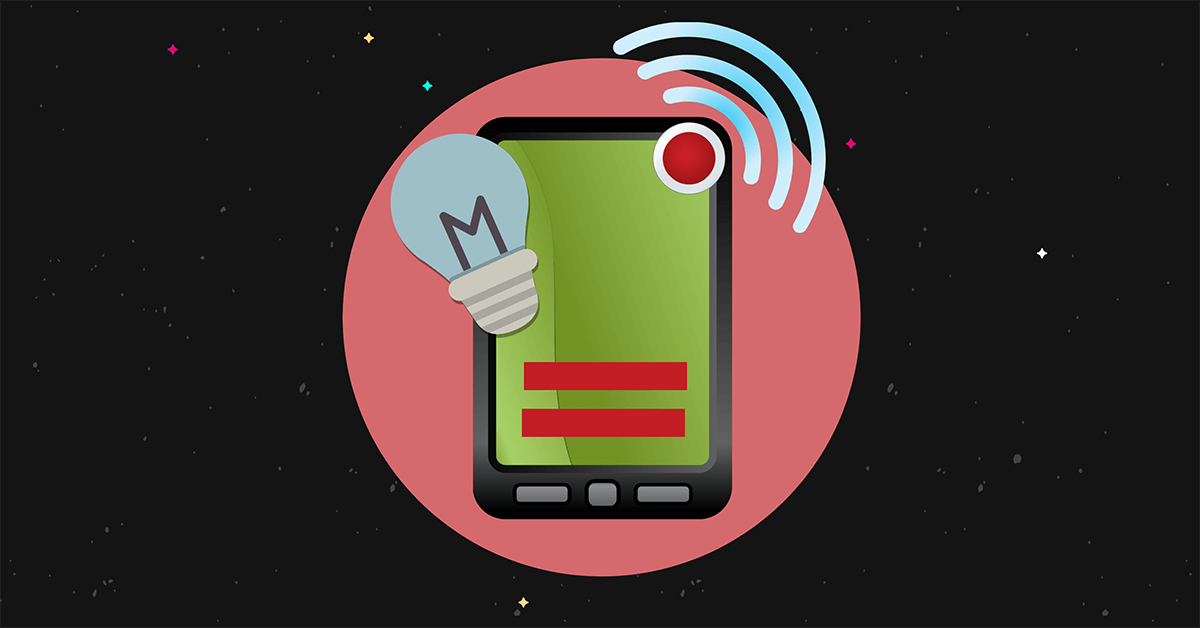Monitive Overview 2021 – The Greatest Uptime Monitoring Software?
If you earn money from your website, you need a reliable uptime monitoring tool that can alert you whenever things aren’t working right.
Why?
Because website downtime can cost you a huge amount of money.
And if you don’t know something is broken, you have no way of fixing it.
This is where Monitive comes in – a powerful yet simple uptime monitoring tool that lets you know as soon as there’s a problem with your website.
In this Monitive review, you’ll learn everything you need to know about this uptime monitoring tool. We’ll be covering features, pricing, and my overall impressions after using this tool to monitor my own websites..
Ready? Let’s get started:
What is Monitive? And who are they?
Monitive is an uptime monitoring service that has been around for more than 10 years.
Their purpose?
Helping online business owners be the first to find out about website outages.
After all, the last thing you want is for your website to go down. Only to find out after hours of lost revenue and your audience getting annoyed.
To solve this problem, Monitive continuously monitors your website and alerts you as soon as there is a problem. And they offer a limited free tier alongside their regular paid plans.
You can get alerts via various channels including SMS and email. And you can get more advanced with ping and TCP checks if you need to.
For example, the last time one of my sites went down, I got a text message letting me know within seconds of my site going down.
We’ll dig into all those features in just a moment.
Why do you need an uptime monitor for your website?
Imagine your business is an actual store.
Everyone is working to make sure the merchandise is properly displayed and categorized. People come into the shop, some buy, some look. It’s all sunshine and rainbows.
Until the store door gets accidentally locked.
People outside are trying to open the door, but are locked out.
That’s the feeling they get when your website is down. It can vary from slight disappointment (oh, let’s try another store) to serious frustration (I cannot return my product to get a refund).
In the online world, your website is the direct line to your business. And things do go wrong from time to time, sometimes more often than seldom.
That’s where Monitive comes in.
What features and tools are included in Monitive Free versus Monitive Pro?
Monitive Free
Now, let’s take a closer look at each feature offered in Monitive Free.
The most basic thing you can do is have your homepage checked with the HTTP Monitor feature. On the Free plan, you get to monitor 1 HTTP page, checked every 10 minutes from a random location around the world.
When an outage occurs, you’ll get an email about it. Once it recovers, you are notified as well.
Every Monday and 1st of the month you’ll get uptime reports to see how your website performed in the previous week or month.
Speaking of performance, Monitive also records response times, which is the time it takes for the server to return the HTML of the page.
This doesn’t include tracking how much time the images and other resources take to load. It’s an indicator of the foundation your website is built upon – your web host.
So, not only are you able to get notifications about downtime, you can also benchmark your web host’s server response times.
All this is included in the “forever free” plan. And it is a good option if you have a simple blog, a personal page, or a basic site. But if your website is generating revenue or you’re running a SaaS platform, it’s probably best to choose the paid plan “Monitive Pro” which is pretty cheap considering the headaches it can solve.
Monitive Pro
The paid version of Monitive provides tools to minimize the downtime your website can experience and having the fastest way to find out when this downtime happens.
I particularly like the Pro version because I get pretty much immediate downtime notifications via SMS. This means I don’t have to be attached to my inbox as much.
One neat approach Monitive have taken is their “modular” approach to uptime monitoring.
So, to avoid you filling your dashboard with metrics and checks that don’t matter to you, you can activate only the specific features you need.
Now, let’s go through the Monitive Pro features.
Monitor 2-500 pages
With Monitive Pro you can have more than one monitored page. The dashboard shows an overview of how all your monitors are performing, and if there are ongoing outages.
For example, I’ve got five monitors running, and I can instantly see how they’re moving along, which ones had problems, and how long ago.
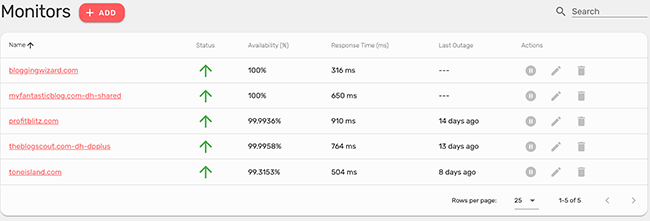
1 minute checks
An important Pro feature is getting monitored pages checked every minute, versus every 10 minutes offered with the free plan.
On any of the monitors, seeing downtime in the past 24 hours, 30 days, or even last year is easy to spot and also makes it easy to detect patterns.
Here’s a screenshot from my guitar blog that had a little bit of downtime recently:
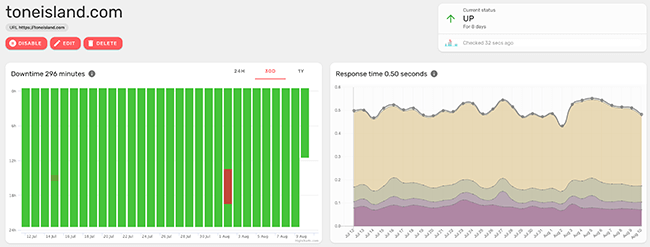
So, any downtime will be outlined in red. Fortunately this was only a temporary issue and the site has bounced back without issues since.
Ideally, what you’ll want to see is something like this:
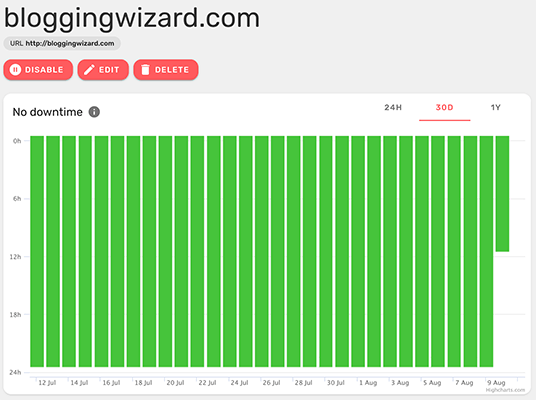
Perfect. No downtime for Blogging Wizard in the past 30 days. A great sign that our host, Cloudways, is doing a good job.
Recent checks are displayed for each monitor in case you’re looking to see if you had an outage and you want to ensure it’s now stable.
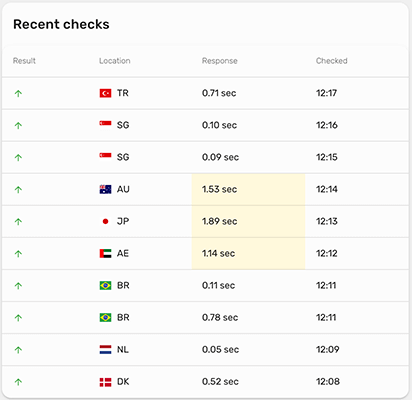
The list of recent checks will also show the test location. As such, response times may be higher in other parts of the world.
So, for example, if your page was checked from a server in China, the response time will be a lot higher.
This is because of the physical distance between the server your website is hosted on and the server running the check.
PING and TCP checks
HTTP checks are good if you’re aiming to check your website. If you want to ensure your home router, or the server you’re managing, is functioning then you’ll need to enable the PING Checks. Monitive will ping the specified host every minute and you’ll find out when it doesn’t get a reply.
In the same manner, if you want to monitor online services that don’t serve websites, such as databases, email, DNS, or even Minecraft, then you’ll need to enable the TCP Checks feature. This enables you to specify the hostname and port for a monitor. Once monitored, Monitive will attempt to connect to the specified host and port, and if it doesn’t succeed, you’ll get an alert.
And speaking of alerts, let’s talk about the alerting channels.
Alerting channels
When your website goes down, getting a simple email is not going to be enough to get your immediate attention. In order to make sure you are reached immediately, Monitive provides several ways to let you know when your website is having a bad day:

Depending on your team’s setup, you can have alerts sent to your Slack workspace, Telegram group or user, and even via SMS text right on your phone:
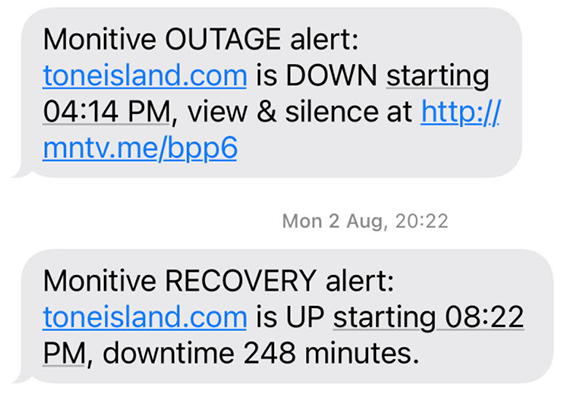
My personal favorite: the phone call alert. I get a lot of notifications throughout the day, but when my website goes down, I want to find out fast.
Since Monitive offers unlimited international phone call alerts with zero setup required, I get peace of mind knowing that if something bad is going on, I’ll be the first to know.
Other alerting channels include Webhooks (calling a script that does something), push notifications (via Pushover), and integrating with PagerDuty for more advanced on-call schedules and complicated setups.
Customizations
Besides the specific settings for a monitor or alerting channels, you can customize the following for any monitor:
- Monitoring locations – Select which of the Monitive monitoring network locations you want your monitor to be checked from. Very useful if your target audience is in a specific geographical area.
- Checking interval – By default, it’s checking your monitors every 1 minute, but if you feel that might be overwhelming or unnecessary, feel free to set it to 5 minutes, 30 minutes, or even 6 hours.
- Timeout period – By default Monitive’s checking system waits for the website or server to reply in 20 seconds. If that doesn’t happen, it considers the monitor down. You can change this to be more or less, as you deem fit.
Keyword monitoring
An empty page can be considered a working website from a computer’s perspective.
And there are some errors that would cause your website to load an empty page. I had this exact issue a few years ago where my security plugin blocked one of the servers used by my content delivery network.
This was a difficult issue to pin-point because the issue only affected visitors based in San Francisco. Eventually I got it figured out but it would have been a lot easier if I was using a tool like Monitive.
Specifically the keyword monitoring feature. It allows you to specify text strings that Monitive needs to look for on the page.
Choosing these specific text strings makes sure, not only that your webpage is served, but also that it has the right content.
Usually, this should be a string at the end of the page, such as the “Copyright © 2021 by ….” or whatever you have on your website, so if anything happens and the server sends only half the page, Monitive will pick that up and send the proper alert, mentioning that the keyword was not found on the page.
This is useful information when you’re on the go and you get an outage alert. Having some hints about what’s wrong helps you know who can fix the problem.
API monitoring
The difference between monitoring a web page and monitoring an API is that APIs are more strict and need specific headers, methods, or a properly formatted body to successfully process a request.
Monitive provides API monitoring, so you can basically monitor authentication requests, custom script actions, or pretty much any kind of requests that can be performed in a single transaction. This is especially helpful for SaaS platforms that rely on the use of API’s.
Status page
Providing a public status page to your visitors demonstrates integrity and transparency for your business. Everyone hopes to have perfect availability, but they also understand that bad things happen. Being open about when it happens builds loyalty and trust.
With Monitive, you can create as many Status Pages as you need, and link to them from your website’s footer or emails, so that if something goes wrong, people can check the status before opening yet another support ticket.
The important thing about status pages is that they need to be hosted elsewhere so your visitors can understand what is going on, and what you’re doing to fix it.
The last thing you want to do is have a status page hosted by the same provider as your main website.
Multi-user accounts
Last, but not least, it’s useful to know that you can add as many users to your account as you need. Monitive doesn’t charge per user, unlike most services. For each user you invite to your “team”, you can pick the role to be either regular or read-only.
And speaking of charging, let’s talk about pricing.
Monitive Pro pricing
So, how much does Monitive cost?
Monitive has a single plan called Pro, but charges per monitor.
You can start with as little as $5 USD per month (yearly payments) for 5 monitors, and go all the way up to 200 monitors at $120 USD per month (again, yearly payments).
If you want to go for monthly payments, the price is varying from $7 to $144 per month.
You can change the number of monitors as you move along, either up or down, and payments are prorated automatically.
There is no binding contract, so you can cancel anytime and still get all the benefits up to the expiration date of your last payment.
Monitive review: the good and bad
Some of the highlights of Monitive that I really enjoyed:
Instant setup. I love that after clicking the start trial subscribe button, I already had one monitor with email, SMS, and Phone call alerts already set up and working.
I appreciate having the uptime reports which I can send to my hosting providers to prove the issues that I had with the website.
Usually, hosting providers just say “it’s working now”, but from now on I have historical information always available.
Getting SMS and Phone Call alerts helps me know about outages without having my mobile data turned on or even available.
What I didn’t like so much about Monitive:
They have no mobile app for iOS or Android. To overcome this, they provide their web app as a Progressive Web App, which you can add to your home screen and use just like a regular app.
My Monitive review: final thoughts
Any online business must have an uptime monitoring service that checks their online presence every single minute, because the cost of downtime is much more expensive than the orders that didn’t go through.
Keeping a high uptime avoids frustrated customers, support tickets, and wasted marketing efforts.
After all, the last thing you want to do is throw marketing budget at your website only for it to go down at the wrong moment.
Monitive is a simple and effective way to keep on top of your website’s availability. It is very easy to set up, and straightforward to use.
Monitive appears to be focusing on small businesses, entrepreneurs, eShop owners, and Software-as-a-Service providers. A simple service for simple businesses.
Are there other uptime monitoring services out there? Absolutely! But they’re usually more complicated or they usually seem designed by engineers, for engineers.
Also, they’re slightly geared towards enterprise customers, which might not be a good fit for your needs.
I found that the flexibility of Monitive is everything I need to keep an eye on my websites.
And that concludes my Monitive review.
Now it’s time to figure out whether Monitive is the right tool for your needs. So start your free trial, set up your first monitor, and see how things go.
Disclosure: This post contains affiliate links. This means we may make a small commission if you make a purchase.
